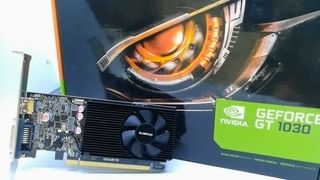Are eGPUs Worth It for Low-End Graphics Cards?
As the market for external GPU enclosures for laptops expands, it has become easier to see the appeal of extending the power of your ultraportable laptop. It's also more tempting to jump right in and buy your first enclosure.

However, with the current inflated prices for GPUs, it might be worth asking: Is an enclosure worth it when you're using a budget-oriented graphics card?
And if your laptop is also on the lower end of the pricing tier, you also need to worry about the bandwidth of the USB Type-C port.
Theoretically, all you need to connect an external GPU is a Thunderbolt-enabled USB Type-C connection. But not every Thunderbolt-enabled port has the same bandwidth.

For example, take a look at the Dell XPS 13 9360 from 2017. Hidden among the specifications is a crucial detail: It has only 2 lanes of PCI Express Gen 3 over Type-C (with a theoretical bandwidth of 16 Gbps), versus what is usually expected of a Thunderbolt connector (40 Gbps).
Ports
Ports (PRTS)
2 USB 3.0 - 1 w/ PowerShare
1 SD card reader (SD, SDHC, SDXC)
1 Headset jack
1 Noble lock slot
1 Thunderbolt 3 (2 lanes of PCI Express Gen 3) supports Power in/charging, PowerShare, Thunderbolt 3 (40Gbps bi-directional), USB 3.1 Gen 2 (10Gbps), VGA HDMI, Ethernet and USB-A via Dell Adapter (sold separately)
So, is it worth it?
Stay in the know with Laptop Mag
Get our in-depth reviews, helpful tips, great deals, and the biggest news stories delivered to your inbox.
The test
The Dell XPS 13 is capable of a lot of gaming given the right adjustments and settings. Popular titles such as Counter-Strike: Global Offensive achieve an average frame rate of 56 fps at 720p, and Far Cry 5 got almost 30 fps on the absolutely lowest settings and resolution. (link to unpublished Far Cry 5 feature here)
However, less-flexible titles such as Assassin's Creed Origins and Final Fantasy XV are completely impossible for Intel HD graphics.




| GT 1030 | Counter-Strike: Global Offensive (Average fps) | Far Cry 5 (Average fps) | Assassin's Creed: Origins (Average fps) | Final Fantasy XV (Benchmark Score) |
| USB Type-C | 146 | 36 | 32 | 3419 |
| Full PCIe | 170 | 48 | 43 | 3694 |
The GT 1030's performance seemed to be between 10 percent and 25 percent of its full capabilities.
Out of curiosity, I repeated the same experiment with a midtier GTX 1050. The effect was, predictably, a more noticeable. For example, Assassin's Creed Origins reached a 60-fps average on the same settings when used fully, but the bandwidth limitations of the port meant that the XPS 13 saw an average of only 45 fps.
| GT 1030 | Counter-Strike: Global Offensive (Average fps) | Far Cry 5 (Average fps) | Assassin's Creed: Origins (Average fps) | Final Fantasy XV (Benchmark Score) |
| USB Type-C | 179.21 | 55 | 46 | 5531 |
| Full PCIe | 227.57 | 81 | 60 | 6239 |
So, is it worth using a budget GPU on a laptop, even if the machine's bandwidth is limited?
I would argue that it is. While there is a definitive performance impact even on the modest GT 1030, the GPU's presence allowed the XPS 13 to reach a solid 30-fps average at 720p on two games that this machine could not play at all before. Even a bandwidth-limited GT 1030 can severely expand the range of games playable on a laptop that has access to only modern Intel HD graphics.
Credit: Shaun Lucas/Laptop Mag
